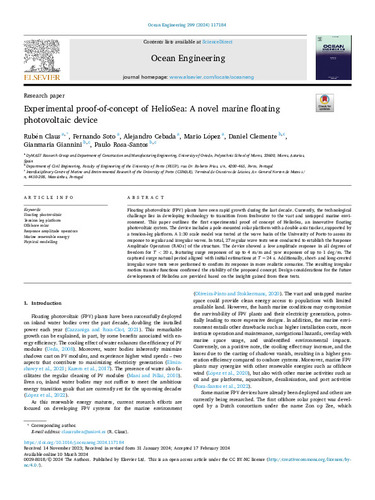Experimental proof-of-concept of heliosea: a novel marine floating photovoltaic device
Autor(es) y otros:
Fecha de publicación:
Versión del editor:
Citación:
Resumen:
Floating photovoltaic (FPV) plants have seen rapid growth during the last decade. Currently, the technological challenge lies in developing technology to transition from freshwater to the vast and untapped marine environment. This paper outlines the first experimental proof of concept of HelioSea, an innovative floating photovoltaic system. The device includes a pole-mounted solar platform with a double-axis tracker, supported by a tension-leg platform. A 1:30 scale model was tested at the wave basin of the University of Porto to assess its response to regular and irregular waves. In total, 27 regular wave tests were conducted to establish the Response Amplitude Operators (RAOs) of the structure. The device showed a low amplitude response in all degrees of freedom for T < 20 s, featuring surge responses of up to 4 m/m and yaw responses of up to 1 deg/m. The captured surge natural period aligned with initial estimations at T = 24 s. Additionally, short- and long-crested irregular wave tests were performed to confirm its response in more realistic scenarios. The resulting irregular motion transfer functions confirmed the stability of the proposed concept. Design considerations for the future developments of HelioSea are provided based on the insights gained from these tests.
Floating photovoltaic (FPV) plants have seen rapid growth during the last decade. Currently, the technological challenge lies in developing technology to transition from freshwater to the vast and untapped marine environment. This paper outlines the first experimental proof of concept of HelioSea, an innovative floating photovoltaic system. The device includes a pole-mounted solar platform with a double-axis tracker, supported by a tension-leg platform. A 1:30 scale model was tested at the wave basin of the University of Porto to assess its response to regular and irregular waves. In total, 27 regular wave tests were conducted to establish the Response Amplitude Operators (RAOs) of the structure. The device showed a low amplitude response in all degrees of freedom for T < 20 s, featuring surge responses of up to 4 m/m and yaw responses of up to 1 deg/m. The captured surge natural period aligned with initial estimations at T = 24 s. Additionally, short- and long-crested irregular wave tests were performed to confirm its response in more realistic scenarios. The resulting irregular motion transfer functions confirmed the stability of the proposed concept. Design considerations for the future developments of HelioSea are provided based on the insights gained from these tests.
ISSN:
Notas Locales:
OA ATUO24
Colecciones
- Artículos [37550]
- Construcción e Ingeniería de Fabricación [508]
Ficheros en el ítem





